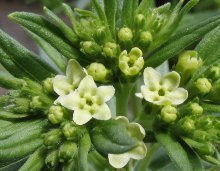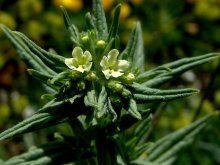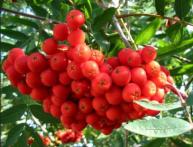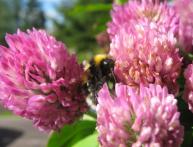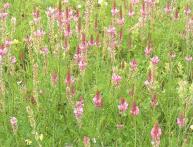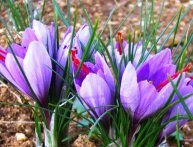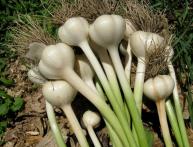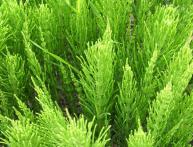Sparrow officinalis: application in cosmetology and folk medicine
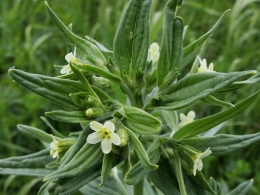
Sparrowweed (Lithospermum officinale L.) is a perennial herbaceous plant, the height of which reaches 80 cm. It is popularly called woodweed, pearl grass, sparrow potion, sun millet, and apothecary seed. The plant has found application in folk medicine, in the traditional one they treat him with distrust.
Content:
- Description of the type and characteristics of the medicinal sparrow
- Agricultural technology for growing plants
- Application in cosmetology and folk medicine
- Recipes of traditional healers
Description of the type and characteristics of the medicinal sparrow
Sparrow belongs to the Borage family. A dicotyledonous plant with a thickened, erect, branched stem, lanceolate leaves arranged alternately. The foliage is dark on top and light green below. It blooms with small, yellowish flowers.
Flowering begins in July, the seeds ripen in white nuts. The area of distribution is Russia, the Caucasus, Ukraine and Siberia. In addition, single specimens of the plant can be found throughout the country. Broad-leaved forests, clearings, forest edges, steppes, meadows, roadsides are the sparrow's favorite places to grow.
Features of the medicinal sparrow
All parts of the plant have medicinal properties. The collection of fruits, flowers, roots and leaves begins in July. They are infused with alcohol, and infusions and decoctions are prepared.The aerial part of the medicinal herb contains mineral salts, pigments, flavonoids.
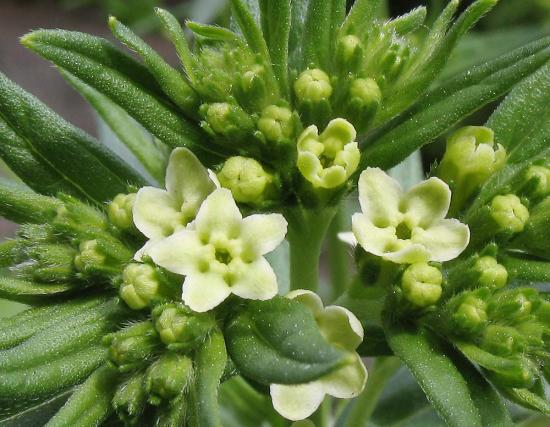
The presence of mucous substances, phenolic and organic acids, and sugars is observed. The leaves contain lithospermic acid; the fruits are rich in phospholipids, oils, and lithospermic acid. The medicinal effects of sparrowweed on the human body have not yet been studied enough. Pharmacological action of sparrow:
- diuretic
- painkiller
- choleretic
- anti-inflammatory
- tonic
- mild laxative
Before using a plant to treat diseases, you must consult a doctor and exclude contraindications to its use.
Agricultural technology for growing plants
Officinalis sparrow can also be grown on your own plot. The plant is considered unpretentious, so it can be grown both in open space and in partial shade. A shady place is not suitable - the plant will be reluctant to develop and bloom. It is not picky about the soil, but it will develop better in fertile soil. Watering frequent is needed, especially in dry times.
It is necessary to loosen the soil regularly to provide air access to the root system and prevent waterlogging of the soil. As for fertilizers, they should not be applied, especially if the plant is grown for medicinal purposes. The only thing is that you can use organic matter - the plant will quickly grow green mass.
It tolerates winters well, so does not require shelter. The sparrow propagates by dividing the bush and by seeds, which are produced in sufficient quantities and have good germination and retain this property for 3 years.
How to prepare raw materials?
Not only the tops of plants are used for medicinal purposes.During harvesting, the upper part, 30 cm long, is cut off. Medicinal raw materials are harvested in July, it is at this time that the sparrow begins to actively bloom. The collected stems are laid out in a dark, well-ventilated room in 1 layer.
The grass is turned over daily, thus preventing the formation of mold. This way the parts of the plant will dry out faster and will not lose their medicinal properties.
Application in cosmetology and folk medicine
In Russia, blush was made from the plant, since when the roots of the plant were crushed, a juice colored red-pink was released. Since the effect of sparrow on the body has been little studied, caution is required when consuming it. The plant is not used in traditional medicine, only in folk medicine.
Sparrow officinalis on video:
In ancient times, sparrowweed was used to crush kidney stones. Scientists tested the effect of the plant on mice and found that it is a good contraceptive. This is why, in the old days, Indian women used the herb to prevent pregnancy.
Sparrowweed as a medicinal raw material is prohibited when:
- thyroid deficiency
- pregnancy
- pituitary gland
- diseases liver
The drug should not be used by children under the age of majority or by nursing mothers. Traditional healers use the plant to treat colds, headaches, bladder stones, and constipation. In ancient times, sparrowweed was used to intensify contractions and facilitate the process of labor.
Recipes of traditional healers
To treat mild forms of hypothyroidism and dysmenorrhea, healers advise using the following drugs and infusions, which include sparrowweed: Under the supervision of a doctor, take 30 drops of alcohol tincture diluted in a glass of water daily.
Grind the dry plant, take 50 g of dried loosestrife and pour 500 ml of boiling water over it. Now you need to leave for 10 minutes, and when the grass sinks to the bottom, strain. The finished infusion must be divided into 3 doses: morning, lunch and evening.
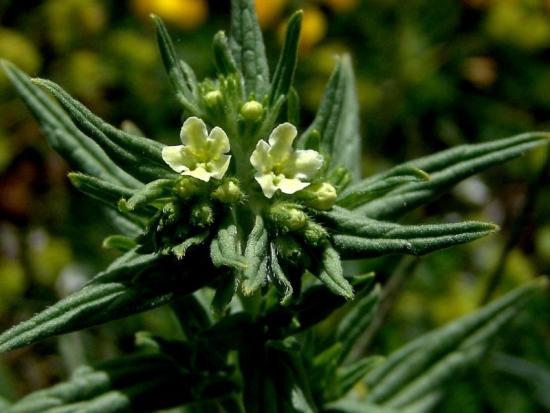
The pharmacy sells capsules that contain sparrow officinalis. As prescribed by a doctor, take 3 gelatin capsules 3 times a day after meals. sparrow drug is a plant that has not been fully studied, so its use for medicinal purposes should be carried out under the supervision of a doctor.
The plant will not cause harm to health and can have a positive effect on the body, provided that the rules for collecting medicinal raw materials are followed. When preparing infusions and decoctions, you must adhere to the dosage and prepare the product in accordance with the given recipe.

